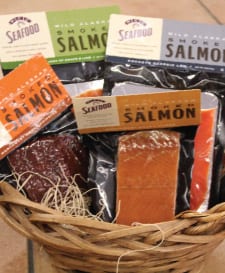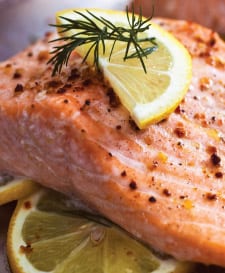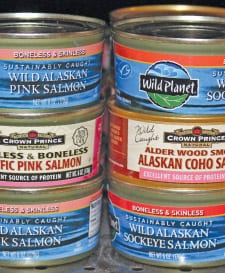Not-just-summer salmon
This article was originally published in February 2012



Like blackberries, apples and other foods emblematic of our region, salmon have a season. But we can enjoy the fish year-round because they often are canned or flash-frozen right where they’re caught, capturing their quality and nutrition. So during winter and early spring, before the rivers teem with summer fish, look for previously frozen, ready-to-cook Sockeye and King in the fresh seafood cases at PCC.
Try our several brands of canned salmon, pre-cooked and ready to add to salads or soups. Don’t miss PCC’s house brand smoked salmon, perfect on a bagel with cream cheese, added to silky pasta, or eaten plain.
PCC’s smoked salmon
Hot-smoked salmon is fully cooked because it’s exposed directly to fire at high temperatures. Try PCC’s plain hot-smoked King and Sockeye from Jensen’s smokehouse in Seattle, plus three unusual flavors smoked just for PCC by Gerard & Dominque Seafoods in Woodinville:
- Honey-Cured — Cured with fresh honey, for a distinctive smokehouse flavor.
- Alehouse Pepper — Cured with Washington-brewed Fish Tale Soundkeeper Organic Ale and coated in fresh-ground black pepper.
- Smoky Chipotle — Lightly coated with a rub of ancho chile, paprika, thyme and oregano.
Cold-smoked salmon (lox-style) is salted then dried for several hours before smoking at low temperatures. The salmon is not held over the fire as in hot smoking, so cold-smoked salmon is not cooked. PCC’s cold-smoked salmon includes:
- Traditional Cold-Smoked — Ruby-red, dry-cured, wild Alaskan sockeye that’s mild and slightly sweet, with a delicate, silky texture.
- Hint of Lime — Dry-cured, then smoked with organic agave nectar and fresh-squeezed lime juice for a hint of acidity.
Did you know?
- The salmon fat containing healthful omega-3s is concentrated in the grey layer just beneath the skin, so when salmon is cooked with the skin on, the fish soaks up these good fats.
- Salmon skin also is edible and contains concentrated nutrients, including omega-3s. The skin and fat, however, also soak up contaminants from the water, so it’s best not to eat the skin every time.
Salmon primer
Salmon in many Northwest rivers have declined in recent decades but many still are robust, especially in Alaska, where salmon fisheries are managed for sustainability. Three species of wild Alaska salmon you’ll find at PCC are:
Chinook (aka King salmon)
- The least abundant and largest of the species, up to 125 pounds.
- Highest fat content of the species: 10.4 grams of fat per 3.5-ounce serving.
Tip from Chef Becky Selengut: Because of its higher fat content, King salmon is great for high-heat cooking methods, such as grilling, broiling or roasting.
Sockeye (aka Red salmon)
- Eats only krill and phytoplankton, not smaller fish, so sockeye have the most astaxanthin, an antioxidant that lends a deep red color noticeably darker than other salmon species.
- Slightly less fat than King: 8.6 grams of fat per 3.5-ounce serving.
- Full flavor and firm texture holds up well in any cooking preparation.
Coho (aka Silver salmon)
- Coho is a later fish than most Sockeye and King runs, so we can enjoy it fresh until fall.
- About half the fat of king salmon:
6 grams of fat per 3.5-ounce serving.
Tip from Chef Becky Selengut: “Coho is a wonderful species of salmon because it has a good amount of flavor and some richness. I tend not to use high-heat cooking methods with Coho because of its slightly leaner profile — instead, steaming, poaching or wrapping in parchment are great.”
